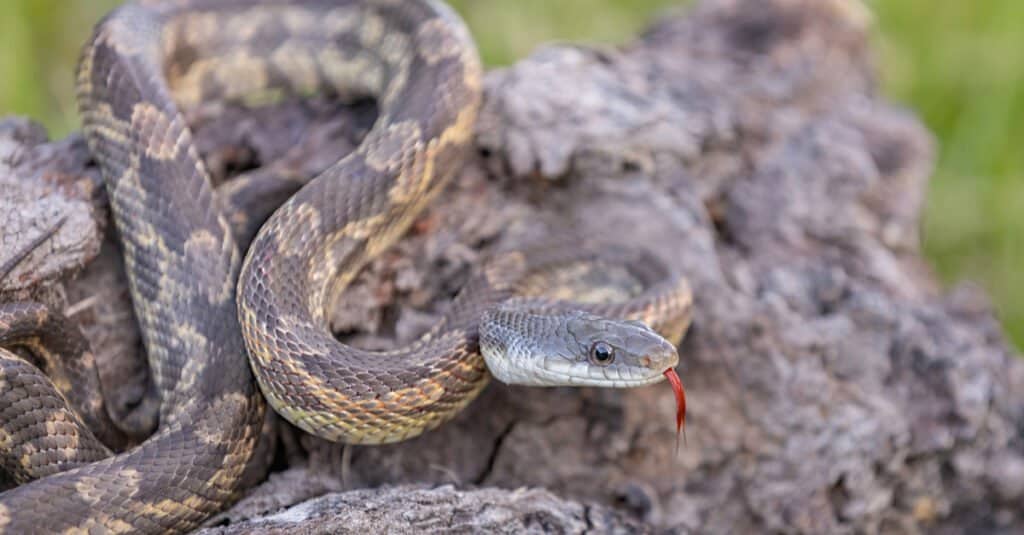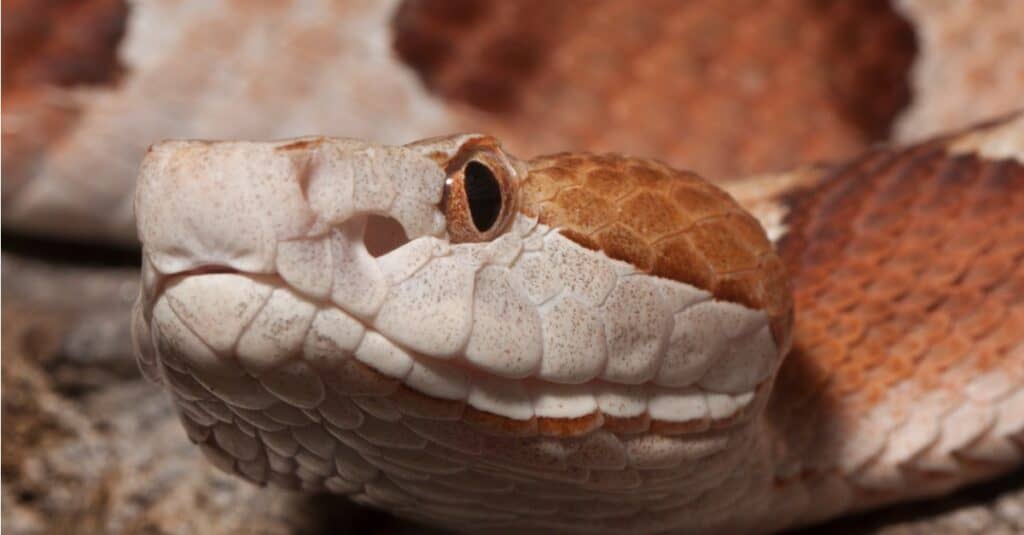Texas rat snakes and copperheads are native to North America and share some traits in common. As ectotherms, they rely on the surrounding environment to regulate their body temperature. They both have incredible striking power. One is a nonvenomous constrictor, while the other is a venomous pit viper. Let’s look at the differences between Texas rat snake and copperhead and see which is which.
Key Differences between Texas Rat Snake and Copperhead

The main differences between Texas rat snakes and copperheads are that they belong to different families, inhabit slightly different ranges, and have unique physical characteristics. They differ in size, reproduce by different methods, kill prey with different strategies, and only one of them poses a threat to humans.
Texas Rat Snake vs Copperhead Comparison
| Texas Rat Snake | Copperhead | |
|---|---|---|
| Scientific Classification | Family: Colubridae; Species name: Pantherophis obsoletus lindheimeri | Family: Viperidae; Species name: Agkistrodon contortrix |
| Range | South-central United States | Central-eastern United States |
| Size | 4-6 feet | 2-3 feet |
| Appearance | commonly yellow or tan with brown to olive-green blotches | reddish-brown bodies with hourglass-shaped cross band patterns of tan, copper, and brown |
| Hunting Strategy | Subdue prey by constriction | Subdue prey by biting with venomous fangs |
| Reproduction | Oviparous | Ovoviviparous |
| Venom | Non-venomous | Venomous |
Texas Rat Snake vs Copperhead: Scientific Classification
The Texas rat snake is part of the Colubridae family of snakes. Its scientific name is Pantherophis obsoletus lindheimeri. This subspecies of the rat snake was named in honor of the German-American naturalist Ferdinand Jacob Lindheimer who first discovered it in New Braunfels, Texas. It was initially classified as part of the genus Elaphe, but is now classified as part of the genus Pantherophis. This genus name essentially means “panther snake” and likely refers to the common markings and physical attributes of this species. This change has not been universally recognized, so some still classify it as part of the Elaphe genus.
The copperhead snake, also known as the eastern copperhead, is a pit viper of the family Viperidae. Its species name is Agkistrodon contortrix. The genus Agkistrodon is shared with cottonmouths and American moccasins. The word comes from the Greek ancistro, which means “hooked,” and odon, meaning “tooth.” Contortrix comes from the Latin contortus, meaning “twisted, complex or intricate,” in reference to the hourglass patches on these snake’s backs. This is a hooked-tooth snake with twisted bands down its back.” The subspecies include the Southern Copperhead (Agkistrodon contortrix contortrix), Northern Copperhead (Agkistrodon contortrix mokasen), Osage Copperhead (Agkistrodon contortrix phaeogaster), and the Trans-pecos Copperhead (Agkistrodon contortrix pictigaster).
Texas Rat Snake Vs Copperhead: Range

The Texas rat snake lives in the south-central region of the United States.
©Silent Shoot/Shutterstock.com
The Texas rat snake and copperhead snakes are both native to North America. They inhabit slightly different ranges, although they do overlap. The Texas rat snake lives throughout the south-central region of the United States. Especially common in Texas, its range also extends into Oklahoma, Arkansas, and Louisiana. Copperheads are found throughout the central and eastern United States. They range from southern New England to eastern Kansas and Nebraska, then south to Texas. They’re also found in localized areas of Mexico. These snakes are comfortable in a variety of habitats, including forests, grasslands, swamps, and urban or suburban areas. They overwinter in crevices, abandoned burrows, caves, hollow logs, and building foundations.
Texas Rat Snake vs Copperhead: Appearance

As venomous vipers, copperheads have vertical pupils.
©iStock.com/Mark Kostich
The Texas rat snake is a relatively long snake with an average length of 4 to 6 feet. Their coloration and patterning vary throughout their range, but they are most commonly yellow or tan, with brown to olive-green blotching along the length of their bodies. White albino snakes are sometimes born. They have solid gray heads and solid gray or white bellies. Texas rat snakes display round pupils.
Copperheads are heavy-bodied snakes that grow 2 to 3 feet, on average. They’re known for their brown bodies with cross-band patterns of tan, copper, and rich brown. Their markings are quite distinctive and commonly take the shape of an hourglass. Their heads are a distinctive rich copper-brown, giving them their common name. Copperheads, like many venomous snakes, have vertical-slit pupils similar to a cat’s eye.
Texas Rat Snake vs Copperhead: Hunting & Diet

Texas rat snakes go after birds’ nests, and copperheads gorge on cicadas.
©South O Boy/Shutterstock.com
The Texas rat snake eats large amounts of rodents and birds, as well as some lizards, frogs, and insects. They subdue most of their prey by constriction. They squeeze their prey, overwhelming their circulatory system and subduing them in order to swallow them whole. These snakes are agile climbers with the ability to reach birds’ nests high in trees. They often eat young chickens and chicken eggs, which has given them the nickname “chicken snake.”
As pit vipers, copperheads have pit organs between their eye and nostril on either side that act like infrared cameras to detect the heat of warm-bodied prey nearby. They also use vision and chemoreceptors on their tongues to find food. They ambush their prey and subdue them with a powerful bite of their venomous fangs. Their diet consists mainly of small mammals like rodents, but they also eat other small reptiles, birds, insects, and carrion. They are adept climbers. A common time for them to be found in trees is the summertime when they will climb to gorge on cicadas.
Texas Rat Snake vs Copperhead: Reproduction
As oviparous snakes, Texas rat snakes lay eggs. Females will lay a clutch of 12 to 20 eggs in hollow logs, compost piles, and other hidden areas. The young hatch about two months later, measuring about a foot long. They receive no parental care and can fall prey to predators like raptors and other snakes. Burying beetles can even be a threat, as they’ll sometimes lay larvae on the snake eggs, which can consume the growing embryo inside.
Copperhead snakes, like other vipers, are ovoviviparous. This means that they give birth to live young, that have developed in the body of the mother snake. They’ll typically give birth to 6 to 8 young at a time. Upon birth, baby snakes may sometimes stay with their mother for several days or until their first skin shedding. However, normally both female and male copperheads do not show parental involvement.
Texas Rat Snake vs Copperhead: Danger to Humans?
Texas rat snakes are non-venomous, and although they can be defensive, they’re typically not dangerous to humans. They can bite if provoked, and their space should be respected. Studies have shown that rat snakes and venomous vipers alike can strike faster than the blink of an eye. Texas rat snakes are relatively shy and will often choose to run away from threats. However, they will sometimes open their mouths and try to bite when disturbed. One of their defensive behaviors is to vibrate their tails or whip against something nearby, producing a ‘rattling’ sound like the more dangerous rattlesnake. If this mimicry fails, the rat snake can produce a foul-smelling musk to deter predators.
In contrast, copperhead snakes are responsible for the largest number of venomous snake bites per year in the United States. This is due to their ability to evade detection through cryptic coloration, remaining motionless, and their association with human-occupied habitats. However, their venom is one of the least toxic of all North American snake species. Copperhead bites cause pain, edema, hemorrhage, fever, and lethargy but rarely lead to death in humans. An article in JAMA estimates that there are 2,920 people bitten by copperheads every year in the U.S., but the fatality rate is only 0.01%.
The photo featured at the top of this post is © Joe McDonald/Shutterstock.com
Discover the "Monster" Snake 5X Bigger than an Anaconda
Every day A-Z Animals sends out some of the most incredible facts in the world from our free newsletter. Want to discover the 10 most beautiful snakes in the world, a "snake island" where you're never more than 3 feet from danger, or a "monster" snake 5X larger than an anaconda? Then sign up right now and you'll start receiving our daily newsletter absolutely free.
Thank you for reading! Have some feedback for us? Contact the AZ Animals editorial team.






